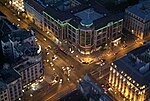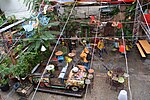Dohány Street Synagogue

The Dohány Street Synagogue (Hungarian: Dohány utcai zsinagóga / nagy zsinagóga; Hebrew: בית הכנסת הגדול של בודפשט, Bet ha-Knesset ha-Gadol shel Budapesht), also known as the Great Synagogue or Tabakgasse Synagogue, is a historical building in Erzsébetváros, the 7th district of Budapest, Hungary. It is the largest synagogue in Europe, seating 3,000 people and is a centre of Neolog Judaism. The synagogue was built between 1854 and 1859 in the Moorish Revival style, with the decoration based chiefly on Islamic models from North Africa and medieval Spain (the Alhambra). The synagogue's Viennese architect, Ludwig Förster, believed that no distinctively Jewish architecture could be identified, and thus chose "architectural forms that have been used by oriental ethnic groups that are related to the Israelite people, and in particular the Arabs". The interior design is partly by Frigyes Feszl. The Dohány Street Synagogue complex consists of the Great Synagogue, the Heroes' Temple, the graveyard, the Memorial, and the Jewish Museum, which was built on the site on which Theodor Herzl's house of birth stood. Dohány Street itself, a leafy street in the city center, carries strong Holocaust connotations as it constituted the border of the Budapest Ghetto.
Excerpt from the Wikipedia article Dohány Street Synagogue (License: CC BY-SA 3.0, Authors, Images).Dohány Street Synagogue
Dohány utca, Budapest Erzsébetváros
Geographical coordinates (GPS) Address Nearby Places Show on map
Geographical coordinates (GPS)
| Latitude | Longitude |
|---|---|
| N 47.495833333333 ° | E 19.060833333333 ° |
Address
Dohány utca 10
1074 Budapest, Erzsébetváros
Hungary
Open on Google Maps









